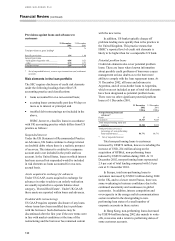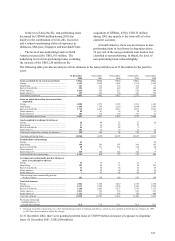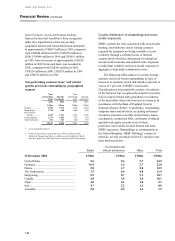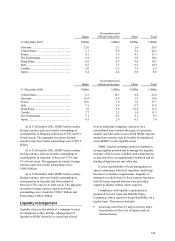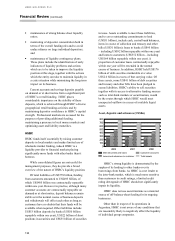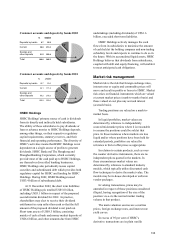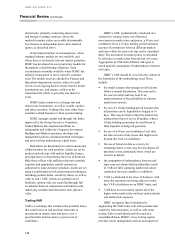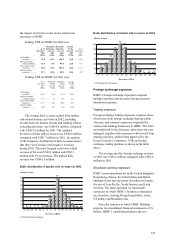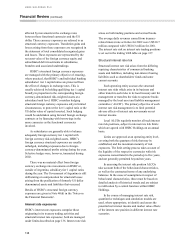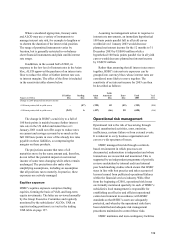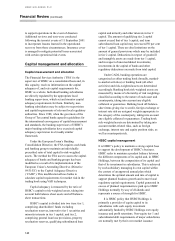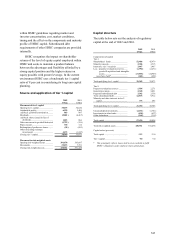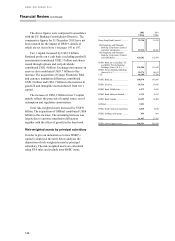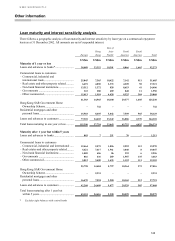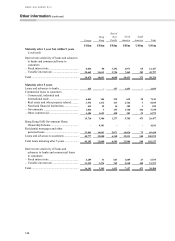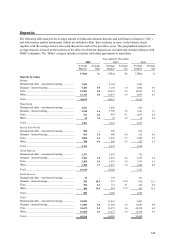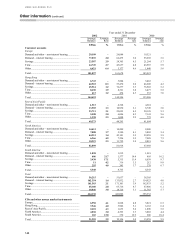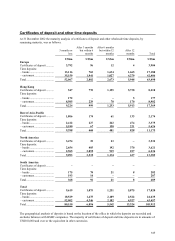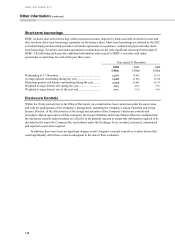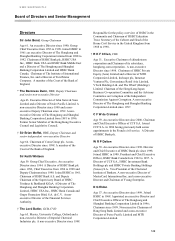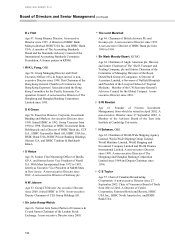HSBC 2002 Annual Report Download - page 142
Download and view the complete annual report
Please find page 142 of the 2002 HSBC annual report below. You can navigate through the pages in the report by either clicking on the pages listed below, or by using the keyword search tool below to find specific information within the annual report.
HSBC HOLDINGS PLC
Financial Review (continued)
140
to support operations in the event of disasters.
Additional reviews and tests were conducted
following the terrorist events of 11 September 2001
to incorporate lessons learned in the operational
recovery from those circumstances. Insurance cover
is arranged to mitigate potential losses associated
with certain operational risk events.
Capital management and allocation
Capital measurement and allocation
The Financial Services Authority (‘FSA’ ) is the
supervisor of HSBC on a consolidated basis and, in
this capacity, receives information on the capital
adequacy of, and sets capital requirements for,
HSBC as a whole. Individual banking subsidiaries
are directly regulated by the appropriate local
banking supervisors, which set and monitor capital
adequacy requirements for them. Similarly, non-
banking subsidiaries may be subject to supervision
and capital requirements of relevant local regulatory
authorities. Since 1988, when the governors of the
Group of Ten central banks agreed to guidelines for
the international convergence of capital measurement
and standards, the banking supervisors of HSBC’s
major banking subsidiaries have exercised capital
adequacy supervision in a broadly similar
framework.
Under the European Union’s Banking
Consolidation Directive, the FSA requires each bank
and banking group to maintain an individually
prescribed ratio of total capital to risk-weighted
assets. The method the FSA uses to assess the capital
adequacy of banks and banking groups has been
modified as a result of its implementation of the
European Union’s Amending Directive (Directive
98/31/EC) to the Capital Adequacy Directive
(‘CAD2’ ). This modification allows banks to
calculate capital requirements for market risk in the
trading book using VAR techniques.
Capital adequacy is measured by the ratio of
HSBC’s capital to risk-weighted assets, taking into
account both balance sheet assets and off-balance-
sheet transactions.
HSBC’s capital is divided into two tiers: tier 1,
comprising shareholders’ funds excluding
revaluation reserves, innovative tier 1 securities and
minority interests in tier 1 capital; and tier 2,
comprising general loan loss provisions, property
revaluation reserves, qualifying subordinated loan
capital and minority and other interests in tier 2
capital. The amount of qualifying tier 2 capital
cannot exceed that of tier 1 capital, and term
subordinated loan capital may not exceed 50 per cent
of tier 1 capital. There are also limitations on the
amount of general provisions which may be included
in tier 2 capital. Deductions in respect of goodwill
and intangible assets are made from tier 1 capital,
and in respect of unconsolidated investments,
investments in the capital of banks and other
regulatory deductions are made from total capital.
Under CAD2, banking operations are
categorised as either trading book (broadly, marked-
to-market activities) or banking book (all other
activities) and risk-weighted assets are determined
accordingly. Banking book risk-weighted assets are
measured by means of a hierarchy of risk weightings
classified according to the nature of each asset and
counterparty, taking into account any eligible
collateral or guarantees. Banking book off-balance-
sheet items giving rise to credit, foreign exchange or
interest rate risk are assigned weights appropriate to
the category of the counterparty, taking into account
any eligible collateral or guarantees. Trading book
risk-weighted assets are determined by taking into
account market-related risks, such as foreign
exchange, interest rate and equity position risks, as
well as counterparty risk.
HSBC capital management
It is HSBC’s policy to maintain a strong capital base
to support the development of HSBC’s business.
HSBC seeks to maintain a prudent balance between
the different components of its capital and, in HSBC
Holdings, between the composition of its capital and
that of its investment in subsidiaries. This is achieved
by each subsidiary managing its own capital within
the context of an approved annual plan which
determines the optimal amount and mix of capital to
support planned business growth and to meet local
regulatory capital requirements. Capital generated in
excess of planned requirements is paid up to HSBC
Holdings normally by way of dividends and
represents a source of strength for HSBC.
It is HSBC policy that HSBC Holdings is
primarily a provider of equity capital to its
subsidiaries with such equity investment
substantially funded by HSBC Holdings own equity
issuance and profit retentions. Non-equity tier 1 and
subordinated debt requirements of major subsidiaries
are normally met by their own market issuance


